Cold Fusion Now attended the Nuclear and Emerging Technology for Space NETS conference held in conjunction with the Lunar and Planetary Institute‘s meeting the week of March 19 in The Woodlands, Texas. It was a fortuitous stop to catch Session 462: Advanced Concepts: LENR, Anti-Matter, and New Physics [.pdf here].
Talks entitled Advanced Propulsion Physics: Harnessing the Quantum Vacuum by Harry “Sonny” White and Project Icarus: Antimatter Catalyzed Fusion Propulsion for Interstellar Missions by R. K. Obousy, not to mention Y. E. Kim‘s Cryogenic Ignition of Deuteron Fusion in Micro/nano Scale Metal Particles, promised a worthwhile trip.
George H. Miley, Professor Emeritus of the University of Illinois Urbana-Champagne UIUC was also scheduled to speak on A Game-Changing Power Source for Spacecraft [.pdf here], a talk outlining a LENR-based General Purpose Heating Source to replace the plutonium currently used in today’s Radioisotope Thermoelectric Generators RTGs that provide heat and electricity to power science instruments on spacecraft.
Dr. Miley has explored nuclear science and plasma research for more than three decades winning numerous prestigious awards for his pioneering work and for which he holds more than a dozen patents. He is also a teacher who founded The Fusion Studies Laboratory at UIUC. He attended the NETS conference with two students presenting a poster session on a plasma propulsion system. [.pdf here]
Innovative Research Produces Excess Heat and Transmutation Products
Since 1989 Professor Miley has been experimenting with unique forms of cold fusion cells, designing electrolytic systems that use multi-layered thin-films of metal as electrodes. More recently, his team has been manufacturing specialty nano-particles coated with thin-films to host to low-energy nuclear reactions LENR.
As editor of the American Nuclear Society‘s journal Fusion Science and Technology, he was one of the few to publish results from early cold fusion experiments. He also worked with Clean Energy Technologies on the Patterson Power Cell, a product developed for commercial power generation which failed to reach market after the death of the inventor James Patterson.
Dr. Miley’s LENR research has shown both excess heat and a wide variety of transmutation products such as iron, copper, calcium, zinc, even gold and rare earth elements have been detected. His cells are composed of super-thin layers of palladium and nickel atop a metal substrate to form an electrode submerged in a heavy water solution. After cycles of loading and de-loading, he hypothesizes that hydrogen (or deuterium) collects in the small cracks and voids between the film layers forming clusters. Superconducting quantum interference devices SQUID have confirmed ultra-dense states of deuterons within palladium crystal defects.
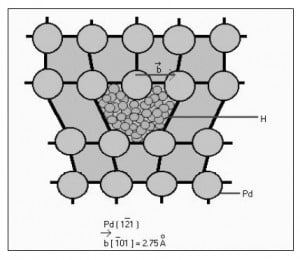
Dr. Miley uses the language nuclear active environment NAE to describe these localized clusters that lead to a reaction, cratering the surface.
When the hydrogen is so close together, an NAE will ultimately produce fusion products, creating both excess heat energy and heavier elements. It is these heavier elements which then may break apart, fissioning, creating the plethora of new transmutation elements directly measured in his cells.
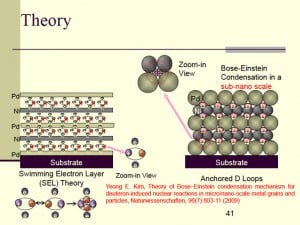
Reversing the polarity of the cell’s electrodes multiple times ‘shakes out’ the loose hydrogen in the electrode. Alternately pushing and pulling the positively-charged nuclei through the metal leaves only the most tightly-bound clusters. After repeating the cycle half-a-dozen times, the available cracks are almost all filled with clusters, increasing the probability of creating a nuclear active environment, and initiating the energy effect. As the loose protons and free electrons shoot back and forth through the material during this loading and de-loading process, they transfer momentum to the clusters, which also may help to initiate the reaction.
Dr. Miley’s current research explores a gas-loaded cell that uses multi-layered thin-film nano-particles in order to increase the number of spaces where clusters can form. The gas-loaded cell type allows for higher temperatures to heat the cell which has been shown to increase the magnitude of excess heat generated.
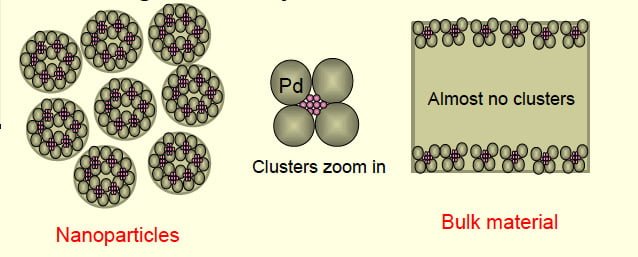
Finding that the deuterium clusters are also superconducting, Dr. Miley has conceived of additional applications that could be developed from this technology. He was at the NETS conference to talk about an idea for a new power source for spacecraft. Right now, many spacecraft power cells use plutonium, a highly radioactive and rare material difficult and expensive to process.

Current RTGs run for 40+ years out into interstellar space. But LENR generators are only now emerging, so how could we test a unit to be sure that it would run that long? Says Dr. Miley, “I could be brilliant or I could’ve made a mistake!”
Scientific Curiosity and Student Interest Led to Cold Fusion Research
I was able to meet Dr. Miley on March 22 one day before his NETS talk. After more than two decades of research into cold fusion, I asked him what his response to skeptics who still doubt the veracity of the findings of Drs. Fleischmann and Pons.
“I wholeheartedly disagree that anything was fraudulent. Certainly, Drs. Pons and Fleischmann – I’ve known them both personally – they are great scientists. A whole web of events caused what I think they would agree was a premature announcement to the public caused all this storm of emotions which was unfortunate.”
“Any personal ramifications of individuals is so unfortunate. But you know that’s happened to many people in the field. The field has had a series of tragic events occur where workers in it have been maligned. Emotions grew so high. It should have been done in a scientific fashion, it would’ve been so much better. But I have nothing but the highest respect for Pons and Fleischmann, such great scientists, anyone would be privileged to follow their lead in science.”
Twenty-three years ago, Dr. Miley was preparing for a plane flight to Japan when he got a call from Steve Jones of Brigham Young University asking if he would consider publishing his paper on ‘cold fusion’ in the journal of Fusion Science and Technology.
Dr Miley recalled saying “I don’t know what cold fusion is, but Steve I know you, and if you think it fits in, please send it to me and I’ll have it reviewed. I said I had to leave immediately for the airport, but ‘I’ll be back in a week and when I get back, I’ll have this paper handled by reviewers.'”
“When I got off the plane, I was surprised by my hosts who were from University of Tokyo. They came waiving the equivalent of the Wall Street Journal saying ‘what is this cold fusion, you’re an American – you must know all about it!’ And I thought ‘my gosh, if I had only taken the time to ask Steve what it was, I could answer your question’. So that was my introduction.”
“When I got back home to my office, suddenly there were five students all waiting for me who a week later wanted to do experiments. At first I was so excited thinking well all these students want to work with me, but then I realized, I happened to have more heavy water than anyone else at the university, so they wanted to use my heavy water. But they did want to work with me too!”
I have never seen so much excitement. I just said OK, if this excites my students like that, I’m all for it, let’s find out what it is.
“So then, I tried to pore over the fax I got, the famous fax that someone released of their paper prematurely around the world. But the time it got to me, it was so mutilated, I had trouble reading it. I tried to understand it as much as possible.”
“The type of work I do, I usually don’t like to repeat someone’s work. My thinking was not to try to repeat what they’d done, but try to think of some other alternate way of doing it. Being a plasma type person, thoughts raced through my mind, what we have to do is load palladium some way, why not load it with a deuterium plasma rather than an electrolytic, since I didn’t know anything about electrolytic chemistry. I learned that later.”
“So my thinking was entirely different than thinking if what they’ve done was correct or not. My thinking was ‘this is real exciting, let’s find out what’s there’.”
“Later, I had the privilege – although I don’t know if it turned out to be a exactly a privilege – I did testify at the first congressional hearing on the subject. I was the only one who hadn’t done any work in it and the congressional aid who asked me to testify said I was an unbiased, innovative researcher, and they wanted one of those stuck in between some of the people who were arguing.”
“So I ended up between Harold Furth who was head of Princeton Plasma Physics Lab, I had known him well since I worked on fusion plasmas. He testified that this whole thing was all a big mistake, that cold fusion never worked and couldn’t replace hot fusion.”
“I spoke next, and then, Martin Fleischmann chided Furth saying ‘we’ve already accomplished break-even’. He was claiming excess heat – that means more energy out than energy put in – by fusion reactions. The two of them then, with me sort of standing by not saying much of anything, got into a huge argument about that. Both were extremely articulate British debaters. Furth has unfortunately since passed away. If you go back to that testimony, I was just fascinated listening to them argue this case, it was like at the debating society again.”
Dr. Miley’s first experiments didn’t work out so well. With Heinz Hora, a theoretical physicist from University of New South Wales, he came up with a concept of Swimming Electron Layer theory, and he decided to make multi-layer thin-films on a plate and hit that with a plasma generated by a plasma focus.
“I thought it was really going to be a great experiment. What happened was as soon as I hit it, all the films fell off! They couldn’t take the plasma heat. So we ended up with nothing.”
“I discussed that with Martin Fleischmann, and he said ‘Well that was a very clever experiment you just have to think about it harder.’ I really like him. Martin really gets to the issue.”
The Patterson Cell
“That was just a technological setback. Anyone whose in science hits those, but that doesn’t stop you, you just have to find out how to go around it. A little bit later, I ran into Jim Patterson. People may not remember all this, he had the so-called Patterson Cell. He was interviewed on Good Morning America. [read transcript] He was going to have a great fusion system.”

“Measure the temperature that came in, measure the temperature that came out, and knowing the flow rate of the fluid, you can figure how much heat went to heat up the fluid. If you knew how much electricity you were putting in for electrolysis, you know how much you were putting in for external power, subtract that to find the amount of excess heat. He was very successful in those early experiments.”
“When I saw him the first time in a meeting, I saw a picture of these beads, I said you know those look like inertial confinement fusion targets, that’s a hot fusion device. I said I know how to make those beads. It turned out I thought I did, but I didn’t”, he laughed.
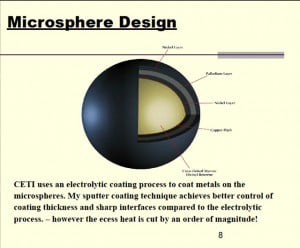
“But when bonded to these beads and expanded, the plastic gave. That allowed it to work. Jim didn’t realize it. I don’t know if I realized it first, but it dawned on me that I could coat these beads with thin layers like I had been doing on the other metal surfaces, and this would work.”
“I continued working with him and also his grandson Jim Reding who had gone to business school and founded a company Clean Energy Technology Incorporated CETI where the granddad was the Chief Technologist and the grandson was running the company. They had a contract with a hot-water heating company. I took some of his beads, and the ones I finally made – incidentally it took me a year to figure out how to do this – that’s why I say I wasn’t as smart as I thought I was, and when I looked at the beads I made under a Scanning Electron Microscope SEM to see how the structure of mine compared to the ones he made, mine really looked great. I had put on a perfectly uniform film with virtually no scratches or defects or anything. His looked horrible. The electroplating had what looked like the mountains on Mars on the surface. Terrible.”
“I used some of mine in one of his devices, and they scarcely worked at all. So that was another setback for me personally, thinking, here I’d done all this work to make perfect films, and they don’t work at all, and Jim’s do. Explain that.”
Well finally, some years later, it began to dawn on me, you don’t want perfect films, that’s a big mistake, you want lousy ones with all these defects in them because that’s where the reactions take place.
“Jim had sort of stumbled on that. He hadn’t realized what it was then either although he had observed hot spots on his beads too.”
“Unfortunately Jim had made a bucket of these beads and later, when he discovered that he’d used them all, he tried to make another batch and the second batch didn’t work right. So non-reproducibility plagued him as well. Then his grandson died prematurely of a heart attack and Jim sort of went out of business after all that. Really sad, cause he was a brilliant person.”
Teaching a New Generation of Scientists
It was the excitement of students that urged Dr. Miley to get that first cold fusion experiment going, and he has remained a dedicated mentor to young people throughout his scientific career. The George H. Miley LENR Undergraduate Scholarship [visit] is a financial award presented to a highly motivated continuing undergraduate student in the department.
Accompanying him at the conference was Paul Keutelian and Akshata Krishnamurthy, two masters degree students who work at the university’s Hyperspace Propulsion Lab. They were presenting a poster session on Helicon Injected Inertial Plasma Electrostatic Rocket, HIIPER [.pdf here].
Mr. Keutelian was interested in science all throughout his childhood and received an undergraduate degree in aerospace. “You have an open mind from your starting point, you really don’t know where you’re going to end up, you just keep going after what interests you. It’s already there, it’s just waiting to be discovered. You just have to keep an eye out. That brought me here.”
Miss Krishnamurthy always wanted to be an astronaut, and studied mechanical engineering before she decided to make rockets. “Dreams do come true, even if they don’t completely, they take you to some place, and you learn a lot in the process.”
As a young woman in this science, Miss Krishnamurthy thinks more women need to come forward and get involved. “Science isn’t just for men. Anybody can do it. It’s just the inquisitive nature that’s required, and the passion to learn.”
“It’s not hard at all”, she says. “It’s not like you have to lift heavy things all day – it’s just having fun in the lab!”
To other young people interested in studying this topic, Dr. Miley said “Not to worry about details of what you’re going to study, it’s what interests you. You want to do something that’s really interesting. You’ve got to find a field like that and keep an open mind. Tackle the problems as they come.”
“If you do that, regardless of what you start with …. , Now a degree in math, that’s such a universal starting point, that’s wonderful, but if you take physics, take science, any of these things, that’s going to help tremendously. It’s an interdisciplinary field, there’s materials science, there’s physics, there’s chemistry, I like to get plasmas in some way. If you have an inquisitive mind, you can put them all together.”
He continued, “I’ve been privileged teaching at an advanced research university, so all the students that I get are highly motivated by the time they get to me – and talented. I know that some other schools, particularly in some of our grade high schools, there’s discouragement, but I think that people just have to be determined.”
To students who are frustrated with their schools, “What they want to do is not let the system stop you, keep pushing it. I think they need to stick it out, better things will come. They’ll find inspired teachers, they may not have one right at the moment, but there’s another one some place they’ll come in contact with.”
“I feel that we can change the system.”
“That’s certainly a motivation if you get caught in that, work towards changing it as time goes on.”
Global Effort for Revolutionary Energy Technology
Dr. Miley has also collaborated with scientists around the world in the unique global effort aimed at understanding the elusive cold fusion reaction. LENR scientists have in part been brought together internationally by the rejection of their research in their home countries.
“When cold fusion was first announced and caused such a commotion, and then many people criticized Pons and Fleischmann, it became quite a negative thing”, says Dr. Miley. “The community decided that they would hold many of their meetings outside of the US because that would free them from the mounting criticism unjustly put against them here in the US.”
“If you look at the international meetings of cold fusion, the ICCF, that have been going on maybe every year or so, they rotate between Italy in Europe – Russia, the upcoming one is in Korea. These meetings brought together international scientists for this very reason. That happened independent of the Internet. The Internet has helped communications. This is either good or bad depending on what your goals are!”
He believes that “International collaboration is great because of the abilities and the new insights you get from others elsewhere. On the other hand, this is competitive world in a global economy and many of us, myself included, would like to see the US the first to develop this. But because of this situation, it may be that its first developed commercially elsewhere. In fact, Andrea Rossi as well as a Greek company Defkalion say they have commercial units already. And if that turns out to be true, this may be commercialized someplace else. Much of this gas-loaded nano-particle work originated in Japan, so you have to assume they may be ahead too.”
“So it’s competitive as well as collaborative.
It’s just the new world we have.”
Dr. Miley doesn’t know if it’s realistic to expect an internationally-funded formal global program working on this. “This is a very commercial field. Most people now are getting into it now because they feel that when the technology becomes commercial it will create money and at the same time, change the whole energy scene, so it’s very competitive.”
“Normally international collaborations like CERN or the international Tokamak are working on something that’s not as game-changing and not as threatening as this could be if somebody else beats you to it, which makes an international group awkward. I’m not sure how well they would collaborate because of each country’s worries about losing this technology. But in principle, it would be great!”
However faraway the benefits of this technology are, Dr. Miley says, “We’ve talked about different issues and challenges, but I’ve become very convinced that this is really a potential game-changing power source, maybe not for RTGs, but in general.
“There’s so many different applications. We can put them in homes, we can put them into space, you can do all sorts of things, it’s quite revolutionary – if it works as my imagination might think it would, or your imagination. So I don’t think I have to convince anyone of that. Anyway, I have gone ahead now and we’re forming a small company called LENUCO which will be based in the research park at University of Illinois to try and commercialize this. But I don’t want to fool anyone, this is a tremendous challenge. I mean, this thing may go belly up, or it may be a great success, I don’t know. It’s going to be one or the other.”
Cold Fusion Now!
Advances In Proposed D-Cluster Inertial Confinement Fusion Target George H. Miley, Xiaoling Yang, Hora Heinrich, Kirk Flippo Sandrine gaillard, Dunstin Offermann, and D. Cort Gautier.
Nuclear Battery Using D-Clusters in Nano-materials by George H. Miley, Xiaoling Yang, Heinz Hora
Condensed Matter “Cluster” Reactions in LENRs George H. Miley, Heinz Hora, Xiaoling Yang
Direct Conversion of Nuclear Radiation Energy by George H. Miley
Transcript of ABC-TV Good Morning America segment on James Patterson from Infinite Energy.
Watch this video through to the end and see Michael McKubre face-off with John Huizenga!

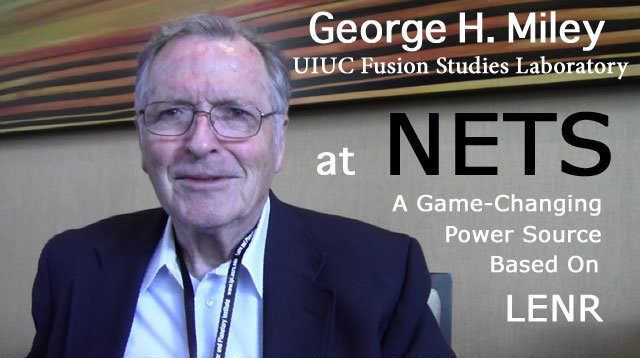

Dr Miley, I salute you and all of your colleagues in this field.
Vision, perseverance and the ability to work under pressure from detractors will bring to fruition what the people of this planet desperately need.
http://www.youtube.com/watch?v=spBOZa87xIY
Well Ruby, are our wonderful scientists going to climb on board after the ship has sailed or stay in their secure taxpayer financed privilege positions denying every possible advance in science beyond the steam.engine.
I think a fair benchmark of when science has grownup beyond irrational denial, abuse and closed-minds will be when they officially face the Truth and call for a full establishment backed unbiased competent investigation into the UFO enigma.
Until then DOGMA rules and ordinary scientists just follow the brain-washing and peer-pressure to keep the plebs under control.
Time for scientists to break Free from the shackles of irrational denial of Evidence for any phenomena and do the bloody Research.
Good interview, Ruby
The “cracks and voids” Miley mentioned also can act as notch antennas which can superfocus ambient electomagnetic fields many thousands of times. If you do a follow-up interview, it would be interesting to know if he thinks this is a key to successful LENR. Also, I am curious if he has used high frequency ultrasound to accelerate the surface cracking.
Dr. Miley – you pave the way in no less a blaze than Copernicus and Galileo. Do NOT let the naysayers diffuse your resolve. LENR is a real phenomenon and YOU can help bring it to the human race. Continue Dr.l Miley. Tell the truth – and the human race WILL be set free.
From e-Cat Site with thanks
Italian LENR Workshop April 10-14
An LENR workshop, the 10th International Workshop on Anomalies in Hydrogen Loaded Metals, is slated to begin tomorrow, April 10th, in Siena, Italy. The conference’s schedule and participants are listed at the bottom of this article, and include Francesco Celani, Dr. Peter Hagelstein of MIT and Prof. Francesco Piantelli. Nichenergy, the company founded to market Prof. Piantelli’s device, is one of the sponsors of the conference. He is scheduled to give a presentation on the last day of the conference, Saturday, April 14th.
The workshops goals are stated thusly:
“High temperature gas loading is a promising technology to reliably create thermal and nuclear anomalies. The purpose of the workshop is to bring together an international group of experts to present their results and encourage discussion. The emphasis is on experimental innovation, methods, instrumentation, diagnostics and theory. In addition there will be afternoon discussions on topics of interest including explanations for the anomalies.”
http://e-catsite.com/2012/04/09/italian-lenr-workshop-april-10-14/
So, in recent days we have been exposed to two competing theories, one from Brillion Energy which says the reaction involving low energy Neutrons happens within the latice and Dr Miley which says it happens on the surface of the lattice with collections of protons which is similar to Widom-Larsen. Let’s have some more experimental evidence to see which one is right
Very informative. It is good to hear Dr. Miley’s back story as regards both P&F and James Patterson.
I really hope Dr. MIley is able to get the funding he needs to move forward. Perhaps the establishment of his private company will help him to that end. Thanks for representing and being the ONLY blogger amongst us to actually show up at NETS. Without you we may be asking “If a space conference takes place in The Woodlands and nobody witnesses it, does it make a sound.” Thanks for making a sound.
Good luck to you Dr. Miley!
Excellent story. I hope to hear a lot more about this gent!
These folks are working on improving budgets and decreasing the carbon footprint from hot fusion colliders. Can electricity from cold fusion reactors help in their endeavors? The timeline for development seems to match up… these colliders are useful for a number of things; yet clearly they cannot compete in the energy marketplace against LENR, not now nor in the conceivable future. What other high energy research devices or research facilities could benefit from LENR?
http://www.smartplanet.com/blog/intelligent-energy/how-to-save-energy-on-particle-colliders/9807?tag=search-river
I simply couldn’t go away your web site prior to suggesting that I extremely loved the standard information an individual provide on your visitors? Is gonna be back frequently in order to inspect new posts